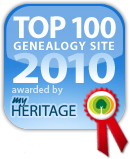I woke this morning to rainy skies in the Chicago area . The weather made me a little worried about my drive back to Midway Airport, especially since the trip from Midway to Schaumburg on Friday took much longer than I expected . With that in mind, I checked out of my hotel room before heading down to the final presentations.
The two final lectures of the 28th Annual Conference of the Polish Genealogical Society of America (PGSA) were both presented by Ceil Jensen . Ceil’s lectures are always entertaining and packed with useful information, and I was sure not to let my mind wander lest I miss something important . Having spent many years as a school teacher, Ceil observes everything going on about her, and she’s sure to notice anyone not paying attention . Still, I haven’t yet seen her assign anyone to detention for not paying attention in her genealogy lectures!
Ceil’s first lecture of the day was entitled Sto Lat: A Plan for finding 100 Years of Ancestors . The lecture was based on her forthcoming book Sto Lat: A Modern Approach to Polish Genealogy to be published by the Polish Genealogical Society of America . Ceil mentioned that a study of our Polish ancestors starts with vital records, the Social Security Death Index, and the US Census.
One of the most important pieces of information Polish genealogists need in order to find their ancestors in Poland is the name of the ancestral village, but even if we know what the name of the village was, we might still have difficulty finding the village on a modern map . Finding villages that might have disappeared from the map, or village names that were later changed, or even the names of villages that were misspelled in our ancestors’ records presents a challenge that may be resolved by consulting Shtetl Seeker . Shtetl Seeker provides a Slavic language-based Soundex that can result in success when the normal English-based Soundex fails.
Ceil also mentioned this blog and Jasia’s blog in her lecture . Thanks for the plugs, Ceil!
The final lecture of the conference, also presented by Ceil Jensen, was on Maps for Genealogy: Old, New and Electronic . I had attended an earlier version of this lecture at the United Polish Genealogical Societies Conference in Salt Lake City this past April, but Ceil’s lecture today presented a lot of new information . One good point that Ceil made in her lecture was that maps of the appropriate time period are crucial to understanding where our ancestors lived, where to find other records concerning our ancestors, and why our ancestors migrated to the places they did . One valuable resource for finding maps of the appropriate time period is Google Earth . With Google Earth, a free, downloadable application, a researcher can find maps of various time periods for the places the world over.
Help with finding maps of various places around the globe for different time periods may be obtained by placing a request with the Library of Congress Ask A Librarian service . With this service, the best results will be obtained by providing information that is as specific as possible, with the exact name and time period of the place and the latitude and longitude of the place in question, if possible.
An excellent set of 1907 maps of Russia-Poland, The Illustrated Geographic Atlas of the Kingdom of Poland can be viewed on the PGSA website.
Military Maps of the Austro-Hungarian Empire from about 1910 are available . These maps cover Galicia, the Austrian Partition of Poland, and include regions adjacent to Austria-Hungary, including Russia, Prussia, and others . By clicking on the appropriate section of the index map, researchers can view a very detailed map of the selected region.
A map of German-Poland is available online in the collections of the University of Wisconsin-Madison in An Atlas of the German Empire . Kartenmeister can provide the corresponding German and Polish names for villages in the Prussian Partition of Poland.
Finally, for maps of Poland today, visit http://mapa.szukacz.pl/ . Type the name of the Polish village or city in the box under Miejscowość and click on the Pokaż button.
So much information was presented at the PGSA Conference, and I can only relay a small amount of that information here . if you have further questions, leave a comment or send me an e-mail . I’ll try to answer your questions directly, but if I don’t know the answer I can let you know how to contact someone else who may be able to help.
Well, I have to be honest, because of my concerns about the weather and my flight schedule, I skipped out on the last 15 minutes of Ceil’s lecture on maps . I suspect she noticed me trying to slip away through the door of the lecture hall, and I’ll have to apologize profusely the next time I see her (and I’ll probably have to make reparations by volunteering at the UPGS Conference in 2008, which Ceil is co-chairing with Linda Ulanski)!
I drove through the rain and reached the airport, where there was quite a long line of cars trying to reach the rental car return location at Midway Airport . One of the airport workers told me that this kind of traffic jam always happens on a big football weekend . No. 1 ranked Notre Dame hosted No. 21 ranked Penn State on Saturday, September 9, so that might have been the game in question.
Final Score from Saturday’s Game: Notre Dame 41 – Penn State 17.
Copyright © 2006 by Stephen J. Danko








